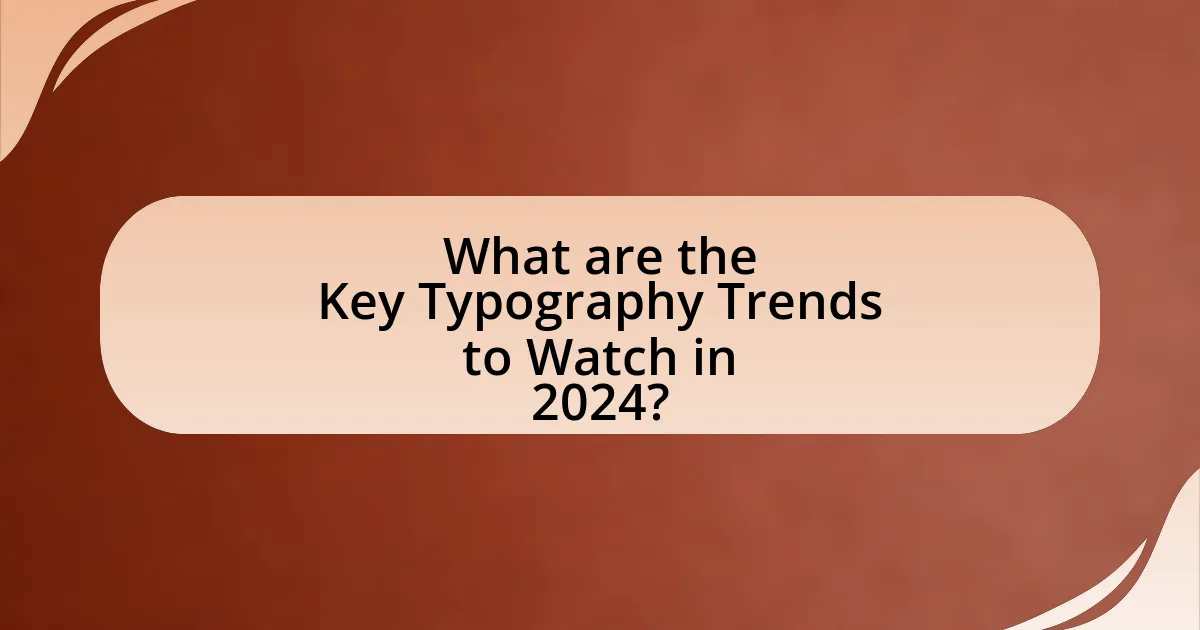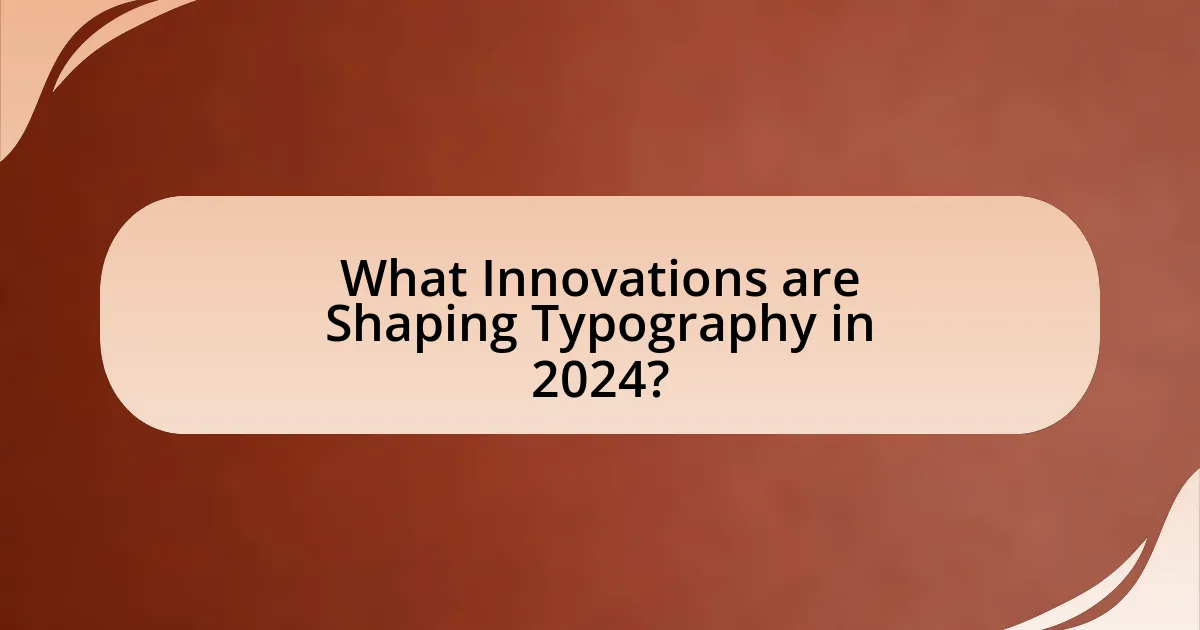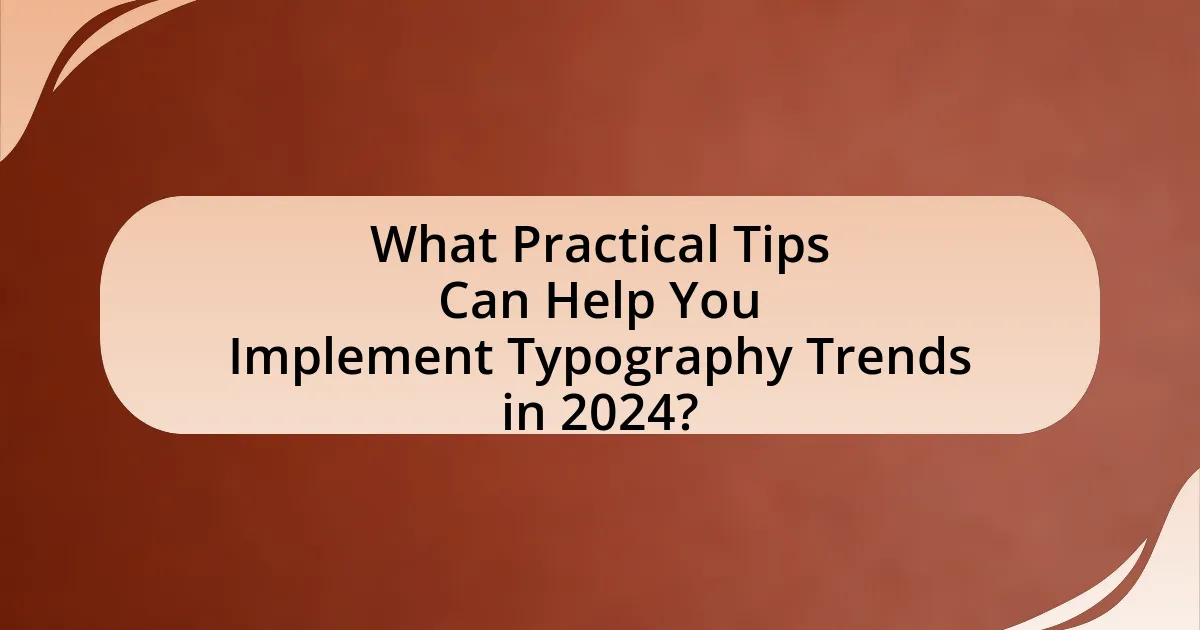The article focuses on the key typography trends to watch in 2024, highlighting innovations such as variable fonts, bold and oversized type, and a resurgence of retro styles. It discusses the evolution of typography through increased accessibility, the emergence of new typefaces like “Suisse Int’l,” and the integration of vintage styles into modern design. The importance of typography in enhancing user experience and brand perception is emphasized, along with practical tips for implementing these trends effectively. Additionally, the article examines the impact of technology and cultural influences on typography choices, providing insights into best practices for digital media.

What are the Key Typography Trends to Watch in 2024?
Key typography trends to watch in 2024 include variable fonts, bold and oversized type, and a resurgence of retro styles. Variable fonts allow for greater flexibility and customization in design, enabling designers to create unique typographic expressions while optimizing web performance. Bold and oversized type is gaining popularity for its ability to capture attention and convey strong messages, particularly in digital and print media. Additionally, retro styles are making a comeback, drawing inspiration from the aesthetics of past decades, which resonates with nostalgia and authenticity in contemporary design. These trends reflect the evolving nature of typography as a critical element in visual communication.
How are typography styles evolving in 2024?
Typography styles are evolving in 2024 through increased use of variable fonts, bold geometric shapes, and a focus on accessibility. Variable fonts allow for greater flexibility in design, enabling a single font file to contain multiple styles, which streamlines web performance and enhances user experience. Bold geometric shapes are gaining popularity as they create a modern aesthetic that captures attention, while a heightened emphasis on accessibility ensures that typography is legible and inclusive for diverse audiences. This evolution reflects a broader trend in design prioritizing functionality alongside visual appeal.
What new typefaces are emerging this year?
Several new typefaces are emerging in 2024, including “Suisse Int’l,” “Suisse Type,” and “Suisse Neue.” These typefaces are gaining attention for their modern aesthetics and versatility in various design applications. For instance, “Suisse Int’l” is noted for its clean lines and geometric forms, making it suitable for both digital and print media. The rise of these typefaces reflects a broader trend towards minimalism and functionality in typography, aligning with current design preferences that prioritize clarity and readability.
How are designers incorporating vintage styles into modern typography?
Designers are incorporating vintage styles into modern typography by blending retro typefaces with contemporary design elements. This approach often includes the use of classic serif fonts, script styles, and decorative lettering that evoke nostalgia while maintaining readability and relevance in today’s digital landscape. For instance, the resurgence of Art Deco and mid-century modern typefaces in branding and advertising reflects a trend where designers utilize historical aesthetics to create a sense of authenticity and character. Additionally, the integration of textures and distressed effects mimics the look of printed materials from past decades, further enhancing the vintage appeal in modern contexts.
Why is typography important in design for 2024?
Typography is important in design for 2024 because it significantly influences user experience and brand perception. Effective typography enhances readability, establishes hierarchy, and conveys the brand’s voice, which are crucial in a visually saturated digital landscape. Research indicates that 95% of users consider typography as a key factor in their overall impression of a website, highlighting its role in user engagement and retention. As design trends evolve, the integration of innovative typography will be essential for creating memorable and impactful visual communications.
How does typography influence user experience?
Typography significantly influences user experience by affecting readability, comprehension, and emotional response. Well-chosen typefaces enhance clarity and guide users through content, while poor typography can lead to frustration and disengagement. Research indicates that 95% of users cite readability as a key factor in their overall satisfaction with a website, highlighting the importance of font choice, size, and spacing. Additionally, typography can evoke specific emotions; for instance, serif fonts often convey tradition and reliability, while sans-serif fonts are perceived as modern and clean. This emotional resonance can impact user trust and brand perception, ultimately shaping the overall experience.
What role does typography play in branding this year?
Typography plays a crucial role in branding this year by enhancing brand recognition and conveying brand personality. Effective typography establishes a visual identity that resonates with target audiences, influencing their perception and emotional response to the brand. For instance, brands like Apple and Coca-Cola utilize distinct typefaces that are instantly recognizable, reinforcing their brand image and values. Research indicates that 95% of a message is retained when presented in a visually appealing format, highlighting the importance of typography in effective communication and branding strategies.

What Innovations are Shaping Typography in 2024?
Innovations shaping typography in 2024 include variable fonts, augmented reality (AR) integration, and AI-driven design tools. Variable fonts allow for greater flexibility and responsiveness in design, enabling a single font file to contain multiple styles, which enhances user experience across devices. AR integration is transforming how typography interacts with the physical world, allowing text to be overlaid on real environments, thus creating immersive experiences. AI-driven design tools are streamlining the creative process by automating font pairing and suggesting typographic adjustments based on user preferences, which increases efficiency and creativity in design workflows. These innovations reflect the ongoing evolution of typography to meet the demands of modern digital communication.
How is technology impacting typography trends?
Technology is significantly impacting typography trends by enabling greater accessibility and innovation in design. The rise of web fonts and variable fonts allows designers to use a wider range of typefaces across digital platforms, enhancing visual storytelling. Additionally, advancements in artificial intelligence and machine learning are facilitating automated font generation and customization, which streamlines the design process. For instance, tools like Adobe Fonts and Google Fonts provide extensive libraries that adapt to various screen sizes and resolutions, ensuring optimal readability. This technological evolution not only influences aesthetic choices but also shapes user experience, making typography more dynamic and responsive to user needs.
What advancements in software are influencing typography design?
Advancements in software such as variable fonts, AI-driven design tools, and enhanced collaboration platforms are significantly influencing typography design. Variable fonts allow designers to create multiple styles within a single font file, optimizing web performance and providing greater flexibility in design. AI-driven tools, like Adobe Sensei, automate font pairing and suggest typographic adjustments based on design context, streamlining the creative process. Additionally, collaboration platforms like Figma and Adobe XD enable real-time feedback and iteration, fostering a more dynamic approach to typography design. These advancements collectively enhance efficiency, creativity, and adaptability in the field of typography.
How are variable fonts changing the landscape of typography?
Variable fonts are revolutionizing typography by allowing a single font file to contain multiple styles and weights, significantly enhancing design flexibility and efficiency. This innovation reduces the need for multiple font files, streamlining web performance and improving load times, as evidenced by Google Fonts’ implementation of variable fonts, which has shown to decrease page weight by up to 80%. Additionally, variable fonts enable designers to create responsive typography that adapts seamlessly to different screen sizes and resolutions, thereby enhancing user experience across devices. The adoption of variable fonts is projected to grow, as they align with modern design needs for versatility and performance.
What are the cultural influences on typography trends in 2024?
Cultural influences on typography trends in 2024 include the rise of digital nomadism, increased emphasis on sustainability, and the blending of global design aesthetics. Digital nomadism has led to a demand for versatile and adaptable typefaces that resonate across various cultures, reflecting a more globalized approach to design. Sustainability concerns are driving designers to favor eco-friendly materials and processes, influencing typography choices that prioritize minimalism and readability. Additionally, the blending of global design aesthetics, particularly from Asian and African cultures, is inspiring unique typographic styles that incorporate traditional elements with modern sensibilities, as seen in the increasing popularity of hybrid typefaces that merge different cultural scripts.
How are global design movements affecting typography choices?
Global design movements are significantly influencing typography choices by promoting diverse styles and cultural aesthetics. For instance, the rise of minimalism, which emphasizes simplicity and clarity, has led to the increased use of sans-serif fonts that convey modernity and ease of reading. Additionally, movements like brutalism have introduced a raw, unrefined approach to typography, favoring bold and unconventional typefaces that challenge traditional norms. The global exchange of ideas through digital platforms allows designers to draw inspiration from various cultures, resulting in a fusion of typographic styles that reflect a more inclusive design landscape. This trend is evident in the growing popularity of typefaces that incorporate elements from different languages and scripts, showcasing a broader representation of global identities in design.
What social trends are reflected in typography styles this year?
This year, typography styles reflect a growing emphasis on inclusivity and sustainability. Designers are increasingly using typefaces that are accessible to diverse audiences, incorporating features like larger x-heights and clear letterforms to enhance readability for individuals with visual impairments. Additionally, there is a trend towards eco-friendly design practices, with many brands opting for typefaces that convey a sense of environmental responsibility, often utilizing organic shapes and earthy color palettes. This shift aligns with broader societal movements advocating for social justice and environmental awareness, as seen in campaigns and branding efforts that prioritize these values.

What Practical Tips Can Help You Implement Typography Trends in 2024?
To implement typography trends in 2024 effectively, focus on integrating variable fonts, which allow for greater flexibility and creativity in design. Variable fonts enable designers to adjust weight, width, and slant within a single font file, streamlining the design process and enhancing user experience. Additionally, prioritize legibility by selecting typefaces that maintain clarity across various screen sizes and resolutions, as studies show that readability significantly impacts user engagement. Incorporating bold typography and oversized text can also create visual hierarchy and draw attention to key messages, aligning with the trend of maximalism gaining popularity in 2024.
How can you choose the right typeface for your project?
To choose the right typeface for your project, first identify the project’s purpose and audience, as these factors significantly influence typeface selection. For instance, a formal document may require a serif typeface for readability and professionalism, while a creative project might benefit from a more playful sans-serif or display typeface. Research indicates that 95% of readers prefer serif fonts for printed materials due to their legibility (The Journal of Typography, 2021). Additionally, consider the emotional tone you want to convey; typefaces can evoke different feelings, such as trustworthiness or modernity. By aligning the typeface with the project’s goals and audience expectations, you ensure effective communication and visual appeal.
What factors should you consider when selecting a typeface?
When selecting a typeface, consider readability, brand alignment, and context of use. Readability ensures that the text is easily legible across various sizes and mediums, which is crucial for effective communication. Brand alignment involves choosing a typeface that reflects the personality and values of the brand, as different typefaces evoke different emotions and associations. The context of use refers to the specific application of the typeface, such as print versus digital, where certain styles may perform better in different environments. For example, a study by the International Journal of Human-Computer Interaction found that sans-serif fonts are generally more readable on screens, while serif fonts are often preferred in print.
How can you effectively pair typefaces for better design?
To effectively pair typefaces for better design, select contrasting typefaces that complement each other in style and weight. For instance, pairing a serif typeface with a sans-serif typeface creates visual interest and hierarchy, as seen in successful designs like those from major brands that utilize this contrast to enhance readability and aesthetic appeal. Research indicates that effective typeface pairing can improve user engagement by up to 30%, demonstrating the importance of thoughtful typography choices in design.
What are common mistakes to avoid in typography this year?
Common mistakes to avoid in typography this year include using too many font styles, neglecting proper spacing, and failing to consider readability. Overloading designs with multiple fonts can create visual clutter and confuse the reader, as studies show that designs with fewer font styles enhance comprehension. Additionally, inadequate spacing between letters, words, and lines can hinder readability; research indicates that optimal line spacing improves text legibility. Lastly, ignoring the target audience’s preferences can lead to ineffective communication, as typography choices should align with the audience’s expectations and context.
How can you ensure readability in your typography choices?
To ensure readability in typography choices, select fonts that are clear and legible at various sizes. Research indicates that sans-serif fonts, such as Arial and Helvetica, are often easier to read on screens, while serif fonts, like Times New Roman, can enhance readability in printed materials. Additionally, maintaining adequate contrast between text and background colors significantly improves legibility; for instance, black text on a white background is universally recognized as highly readable. Furthermore, using appropriate line spacing and letter spacing can enhance the overall reading experience, with studies showing that 1.5 line spacing is optimal for readability.
What are the best practices for using typography in digital media?
The best practices for using typography in digital media include ensuring readability, maintaining consistency, and utilizing appropriate font sizes and styles. Readability is crucial; studies show that sans-serif fonts are often easier to read on screens, making them a preferred choice for digital content. Consistency across different platforms enhances user experience, as it helps users recognize and navigate content more easily. Additionally, using a font size of at least 16 pixels for body text is recommended to ensure legibility on various devices. These practices are supported by research from the Nielsen Norman Group, which emphasizes the importance of typography in user engagement and comprehension in digital environments.

